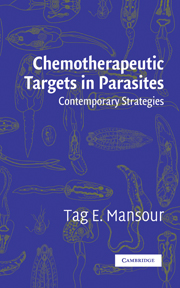Book contents
- Frontmatter
- Contents
- Preface
- Acknowledgments
- 1 The Search for Antiparasitic Agents
- 2 Biophysical, Genomic, and Proteomic Analysis of Drug Targets
- 3 Energy Metabolism in Parasitic Helminths: Targets for Antiparasitic Agents
- 4 Antimalarial Agents and Their Targets
- 5 Antitrypanosomal and Antileishmanial Targets
- 6 Targets in Amitochondrial Protists
- 7 Neuromuscular Structures and Microtubules as Targets
- 8 Targets in the Tegument of Flatworms
- Epilogue
- Index
- References
2 - Biophysical, Genomic, and Proteomic Analysis of Drug Targets
Published online by Cambridge University Press: 11 August 2009
- Frontmatter
- Contents
- Preface
- Acknowledgments
- 1 The Search for Antiparasitic Agents
- 2 Biophysical, Genomic, and Proteomic Analysis of Drug Targets
- 3 Energy Metabolism in Parasitic Helminths: Targets for Antiparasitic Agents
- 4 Antimalarial Agents and Their Targets
- 5 Antitrypanosomal and Antileishmanial Targets
- 6 Targets in Amitochondrial Protists
- 7 Neuromuscular Structures and Microtubules as Targets
- 8 Targets in the Tegument of Flatworms
- Epilogue
- Index
- References
Summary
Biophysical Techniques for Studying Drug Targets
X-Ray Crystallography
Once a selective parasite target has been identified the next step is to obtain its three-dimensional (3-D) structure. Crystallography remains the most desirable method for understanding the structure of the target, its binding sites, and the chemical groups involved in electron and steric interaction with substrates or inhibitors. The initial step toward achieving this goal is the preparation of large enough crystals of the protein. In the past this has been difficult because of the scarcity of parasite material as a source of the target protein. This is now a less serious handicap because the molecular biological techniques of cloning, polymerase chain reaction PCR, and expression of target genes in bacterial or insect cells can be used. It is now possible to obtain highly purified recombinant proteins in milligram amounts. The protein is placed in a solution of ammonium sulfate, the concentration of which is gradually increased to avoid precipitation of an amorphous protein. Having patience and a “green thumb,” which may come with practice, seem to be valuable elements for preparing crystals. Although the principles of X-ray crystallography were established more than fifty years ago, there have been many improvements in X-ray generators and detector systems. The development of synchrotron radiation sources has increased the accuracy and speed of analysis of crystals (Hunter, 1997). The development of computer analysis and graphics that can display different parts of the protein molecule on a monitor is very useful.
- Type
- Chapter
- Information
- Chemotherapeutic Targets in ParasitesContemporary Strategies, pp. 19 - 32Publisher: Cambridge University PressPrint publication year: 2002

